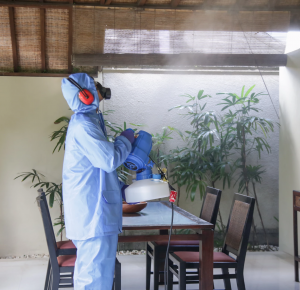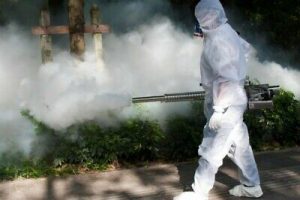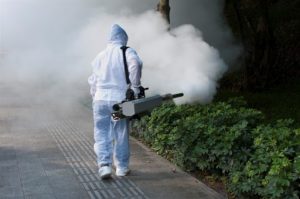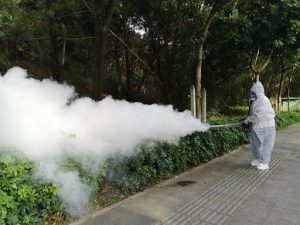Thermal Fogging Treatments:

What Is Thermal Fogging?
Thermal Fogging is the generation of ultra-fine droplets in a range of 1-50 using thermopneumatic energy. Liquid substances are vaporised at the end of the fogging barrel (resonator) and form ultra-fine aerosols by condensing on contact with cool ambient air. On being ejected it creates dense visible fog-clouds. Pure oil solutions or aqueous liquids with a glycol component are especially suitable for this purpose.
Uses of Thermal Fog:
Thermal Fogging is used for any pest control task where active substances should be uniformly distributed even in inaccessible places, without leaving undesirable residues. This fogging method is the solution for treating large areas and spaces with a minimum quantity of pesticide solution used, less operational work and with little harm to the environment (less residues and no penetration into the ground). Thermal fog generators consist of a carburettor, mixer tube, a combustion chamber and a resonator. A pulsating gas stream is created through burning of fuel-air mixture, where the solution is inserted into the pulsating hot gas stream at the open end of the resonator, developing a dense fog when used outdoors. With the right active ingredient, it successfully destroys flying and crawling insects, as well as, germs and bacteria. In suitable weather conditions the thermal fog shows effects in a very short time. When used indoors it completely fills the space reaching even small cracks & crevices.
Preparing Areas for Fogging Treatments:
These preparations will help to ensure maximum effectiveness for your treatment procedure:
- Close all exterior windows and doors
Before Fogging Treatments:

By following the below safety steps, this will ensure worker, occupant and premise safety:
- Make sure that all individuals and their pets have left the area
- Notify the local fire department about what will be carried out at the particular premise
- It is also helpful to place warning notices on treated areas, indicating time when occupants can return back into treated area
- All technicians need to wear appropriate safety gear, such as eye protection and respirators
- Shut off all gas mains at the treated premise, such as: open flames (including pilot lights)
- Cover or disable smoke detectors, as the fogging smoke will trigger them
- Cover fish tanks and food containers
After Fogging Treatment:

Be sure to leave the treated area undisturbed for at least 4 hours. This will allow for maximum penetration of the fogging solution into all cracks & cervices.
How Long Should I Stay Out of the Treated Area After Fogging Treatment?
Most foggers or bombs recommend that you stay out of the treated area for approximately 5 hours, then followed by at least another 1 to 2 hours of ventilating the home, by opening the doors and windows.
Thermal Fogging Advantages:

- Excellent distribution at low output
- Fogging of water or oil based solutions without solution waste
- Quick and effective application
- Less time consuming than conventional spraying
- Higher efficiency, as it reaches into normally inaccessible areas
- Fog reaches even into the smallest cracks & crevices
